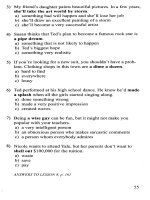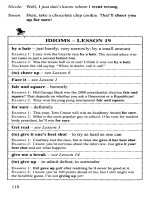Science reason english 1 potx
Bạn đang xem bản rút gọn của tài liệu. Xem và tải ngay bản đầy đủ của tài liệu tại đây (479.85 KB, 6 trang )
2. In order for 250 g of sugar to completely dissolve in 100 g of water, the temperature of the solution
would have to be at a minimum of:
f. 15 degrees Celsius.
g. 25 degrees Celsius.
h. 45 degrees Celsius.
j. 65 degrees Celsius.
3. At 100 degrees Celsius the solubility of sugar in water would most likely be:
a. less than 250 g of sugar in 100 g of water.
b. between 250 g of sugar and 350 g of sugar in 100 g of water.
c. between 350 grams of sugar and 400 g of sugar in 100 g of water.
d. more than 400 grams of sugar in 100 g of water.
4. In order to produce rock candy at 20 degrees Celsius from a solution of 300 g of sugar not completely
dissolved in 100 g of water, the solution must be:
f. first heated above 60 degrees Celsius, then slowly cooled to 20 degrees Celsius.
g. slowly stirred at 20 degrees Celsius.
h. slowly cooled to 0 degrees Celsius.
j. slowly cooled below 0 degrees Celsius, then heated to 20 degrees Celsius and stirred.
5. How much sugar must be added to a solution of 50 g of sugar in 100 g of water at 45 degrees Celsius
in order for the solution to be supersaturated?
a. more than 10 grams
b. more than 20 grams
c. more than 100 grams
d. more than 200 grams
6. Solubility is defined as:
f. a supersaturated mixture.
g. a mixture that is made by dissolving a solute in a solution.
h. the amount of solute that can be dissolved in a solvent at a given temperature.
j. the temperature that causes supersaturation.
7. What is the approximate difference in temperature for the solubility of 200 grams of sugar/100 grams
of water and 250 grams of sugar/100 grams of water?
a. 10 degrees Celsius
b. 20 degrees Celsius
c. 30 degrees Celsius
d. 40 degrees Celsius
– ACT SCIENCE REASONING TEST PRACTICE–
284
8. In a solution of sugar and water, which is the solvent and which is the solute?
f. solvent: sugar; solute: water
g. solvent: rock candy; solute: water
h. solvent: water; solute: sugar
j. solvent: water; solute: rock candy
Passage II
You set up an experiment to investigate the different rates at which soil and water heat and cool.
You use the following equipment:
Thermometers (measuring in °C)
Container of soil
Container of water
Radiation Lamp
Timer
You obtain the temperature of the soil and water over a period of time and collect the following
data:
DATA TABLE I: During Heating-up Period
TIME (MIN) SOIL TEMPERATURE (°C) WATER TEMPERATURE (°C)
0 20.0 20.0
1 21.0 20.5
2 22.0 21.0
3 23.0 21.5
4 24.0 22.0
5 26.0 22.0
6 27.0 22.5
7 28.5 22.5
8 30.0 23.0
9 31.0 23.0
10 32.0 23.0
– ACT SCIENCE REASONING TEST PRACTICE–
285
DATA TABLE II: During Cooling-off Period
TIME (MIN) SOIL TEMPERATURE (°C) WATER TEMPERATURE (°C)
11 32.0 22.5
12 31.0 22.5
13 30.5 22.0
14 29.5 22.0
15 28.0 22.0
16 27.0 21.5
17 26.0 21.5
18 25.0 21.0
19 23.5 21.0
20 22.0 20.5
The following graph was then made using the data.
9. Based on the results of the experiment, what is true about the heating and cooling rates of soil and
water?
a. Water heats faster, but cools slower.
b. Water heats and cools faster.
c. Soil heats faster, but cools slower.
d. Soil heats and cools faster.
Temperature of Soil and Water
versus Time
30
34
32
28
26
24
22
20
0 5 10 15 20
Soil
Water
Temperature (°C)
Time (minutes)
– ACT SCIENCE REASONING TEST PRACTICE–
286
10. During the heating-up period, which surface was raised to a higher temperature?
f. soil
g. water
h. They were raised in temperature by equal amounts.
j. You cannot tell based on the data given.
11. If you repeated this experiment but you let the water and the soil heat for 20 minutes and then cool for
20 minutes instead of the 10 minutes used in this experiment how would you expect the graph of tem-
perature versus time to change?
a. Only the soil temperature curve would change. The water temperature curve would remain the
same.
b. Both the soil and the water temperature curves would change so that they would have the same
basic shape but higher maximum temperature values.
c. Both the soil and water temperature curves would change shape but maintain the same maximum
temperature values.
d. Only time for the experiment would change. The soil temperature and water temperature curves
would remain the same.
12. Based on this experiment, compare the heating and cooling of air masses above the ocean and the
land.
f. The air above the ocean and land heats and cools at the same rate.
g. The air above land heats and cools faster.
h. The air above the ocean heats and cools faster.
j. The air above the land heats faster but the air above the ocean cools faster.
13. Predict the relative air temperature over ocean and land during the day and night.
a. During the day: air above the land is warmer, above the ocean is cooler. At night: air above the land
is cooler, above the ocean is warmer.
b. During the day: air above the land is cooler, above the ocean is warmer. At night: air above the land
is warmer, above the ocean is cooler.
c. During the day: air above the land is cooler, above the ocean is warmer. At night: air above the land
is cooler, above the ocean is warmer.
d. During the day: air above the land is warmer, above the ocean is cooler. At night: air above the land
is warmer, above the ocean is cooler.
– ACT SCIENCE REASONING TEST PRACTICE–
287
14. A sea breeze is a breeze blowing from the ocean onto the land. Air moves from cooler regions to
warmer regions. When would a sea breeze occur?
f. Sea breezes occur during the night.
g. Sea breezes occur during the day.
h. Sea breezes occur during the night and the day.
j. Sea breezes never occur.
15. You complete this experiment a second time, and find that the water reached a higher temperature
than the soil. Which of the following could be used to explain why your results are different?
a. The water was unfiltered.
b. The soil came from your garden.
c. The heating lamp was faulty.
d. You used different sized containers in the second experiment.
16. What is the difference in temperature between soil and water during the 13th minute?
f. 7 degrees Celsius
g. 7.5 degrees Celsius
h. 8 degrees Celsius
j. 8.5 degrees Celsius
Passage III
The heart is an organ that pumps blood throughout the circulatory system in the body. Red blood
cells are a tissue in the body that carry nutrients to the body’s cells and waste away from the body’s
cells. The heart rate increases or decreases depending on the body’s needs to transport nutrients
and waste.
In an experiment, a female had her heart monitored. For one minute, she sat in a chair qui-
etly. At the end of the first minute to the end of the third minute she did jumping jacks. Finally,
she sat again in the chair and waited until her heart rate went back to her resting heart rate as meas-
ured in the first minute. After performing this experiment, the following graph was created.
– ACT SCIENCE REASONING TEST PRACTICE–
288
Graph 1
17. How long did it take for the resting heart rate to return after the exercising stopped?
a. 1 minute 15 seconds
b. 1 minute 30 seconds
c. 1 minute 45 seconds
d. 2 minutes
18. How long did it take for the heart rate to respond to the initial exercise?
f. 1 minute
g. 45 seconds
h. 30 seconds
j. 15 seconds
19. Which of the following is an accurate pattern found in Graph 1?
a. The recovery time is shorter than the time it took for the heart rate to peak, due to the increase in
exercise.
b. The recovery time is longer than the time it took for the heart rate to peak, due to the increase in
exercise.
c. The recovery time is equal to the time it took for the heart rate to peak, due to the increase in
exercise.
d. The recovery time was equal to the resting heart rate time.
120
160
140
100
80
60
40
0
20
012 453
6
Heart beats per minute (heart rate)
Time (minutes)
– ACT SCIENCE REASONING TEST PRACTICE–
289









